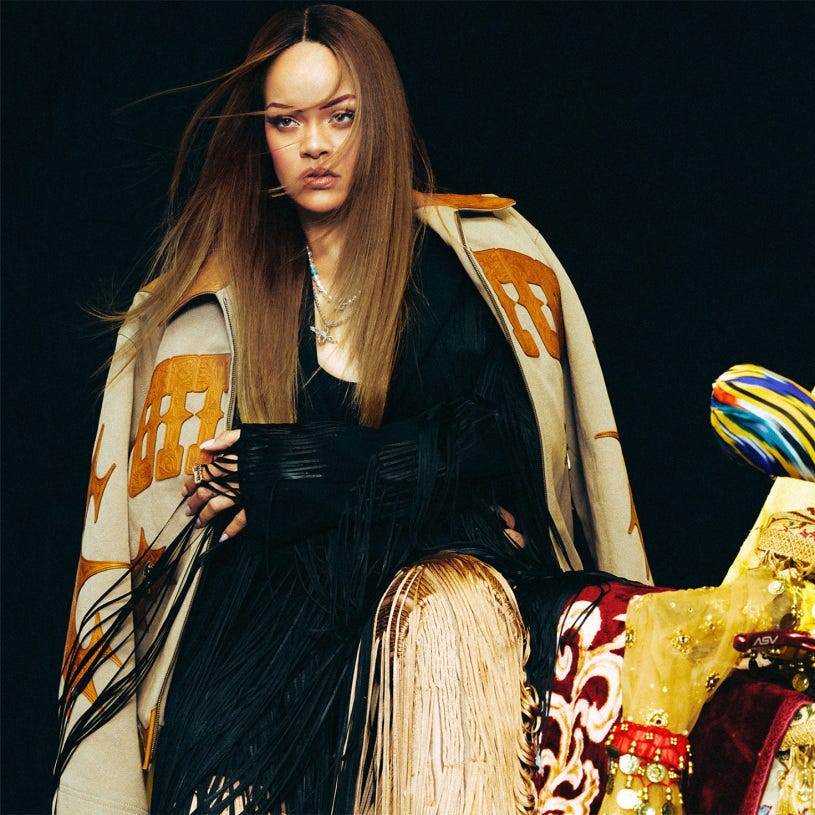Hey, it’s Camilla. Welcome to this month’s edition of ClubGrowth, your weekly growth and product marketing content on your favourite brands. Each week I look at a different brand case study and sum it up for you in the most digestible way possible, so you can read it on the go. This newsletter is free, but in future you’ll have to subscribe get access to the archive!
This month we discussed Luxury Thrifting and Fenty Beauty’s Asia expansion. Now, without further ado, let’s talk about BadGirlRiri!
Music and now beauty mogul, Rihanna’s Fenty Beauty, is headed to mainland China. The internet is once again abuzz because of its viral digital rollout, on Weibo and Vogue China. This isn’t a first in the world of luxury, the LVMH brand is simply following the multi-billion dollar footsteps of brands like Estée Lauder, Chopard, Swarovski, and their very own Sephora. Fenty Beauty products will officially be available online and in-store from Sephora in China on the 1st of April 2024.
Why are beauty brands expanding to China?
China boasts a $63 billion beauty market that has become increasingly attractive to Western luxury brands over the last decade. Their luxury and beauty markets are powered by a strong digital infrastructure that allows e-commerce to flourish and contributes to the strong trust in online shopping from citizens. The country currently has the biggest and most diverse e-commerce market in the world, and it is set to be valued at $4 trillion by 2027.
Additionally, consumer behavior among millennials and Gen Z has shifted from previous generations. The younger consumers are motivated by individualism and self-expression. This has opened the gap for both Western and niche brands from other countries to penetrate the market. Globally, today’s consumers are less likely to simply purchase legacy brands based on their history. Niche beauty, as a topic, went from being reserved for beauty insiders to becoming one of the top trending topics on platforms such as Weibo, WeChat, and TikTok (Douyin). Niche skincare sellers are thriving on these platforms, resulting in the boom of niche brands like Drunk Elephant and Skinceuticals. These brands also partnered with local e-commerce platforms such as Alibaba. For example, Drunk Elephant quickly became a top ten beauty product in China due to its popularity on Tmall, while Skinceuticals made over 14 million dollars from its first Tmall launch.
Finally, the growth of Cross Border E-commerce (CBEC) has taken care of the stumbling block that was the National Medical Products Administration (NMPA) registration. This means that global brands can ship their products to China with decreased regulation. CBEC import has been growing by 24% year on year in the Chinese market, making expanding to China a no-brainer for strong brands like Fenty Beauty.
How can Fenty Beauty achieve success in the Asian Beauty Market?
Prioritize digital strategy while taking advantage of the traditional brick-and-mortar store channel: Fenty Beauty has already started making inroads in the digital space by announcing their expansion on Weibo, a platform with close to a billion active users. Moreover, Fenty Beauty has the advantage of utilizing Sephora as a physical distribution and user acquisition channel.
Tailor the branding to honor Chinese culture and aesthetics: Chinese consumers prefer brands that resonate with their existing beauty aesthetics and culture. Fenty has already begun doing this in their Vogue China campaign, where the diverse models and Rihanna’s covers resonate strongly with Chinese beauty standards and makeup techniques. They could also take advantage of niche Chinese marketing tactics like live streaming to drive sales and brand awareness in their first few weeks of launch to ensure a return on their investment.
Developing strategic partnerships with local brands. Fenty Beauty has the opportunity to collaborate with local brands, celebrities, key opinion leaders, and influencers to drive home their commitment to honoring the Chinese consumer while increasing product adoption.
Take advantage of UGC content created by the Chinese Diaspora: Getting the Chinese diaspora especially from Macau and Hong Kong to join in on the fun to create UGC content could also strike gold for the brand. They have already used the product and can showcase how to achieve specific looks and aesthetics on social media to keep driving brand momentum.
China has a population of 1,5 billion people who have already cultivated a strong e-commerce culture, this, combined with a thriving beauty and luxury market sets brands up for success despite geopolitical issues and an economic downturn. However, this does not mean brands are guaranteed success in the Chinese market, because as many have succeeded many have also failed, for example, Revlon. Revlon failed to tailor its product to the local market, they did not invest heavily in both traditional and digital marketing resulting in lower exposure and poor consumer perception. The key seems to be prioritizing digital marketing and distribution strategy while honoring the Chinese consumer. We are certainly likely to see more and more brands make a case for themselves in the Chinese market in the next few years.





